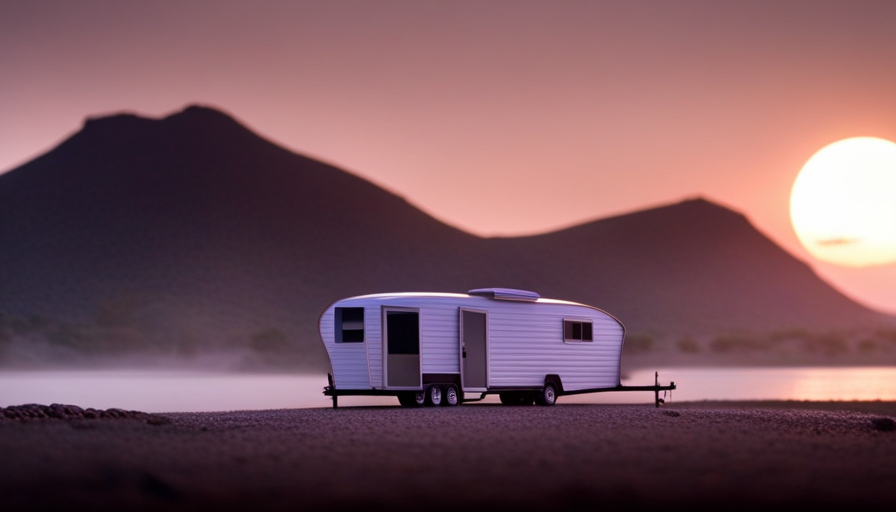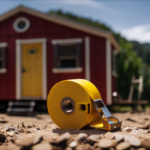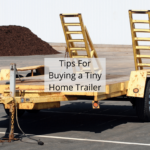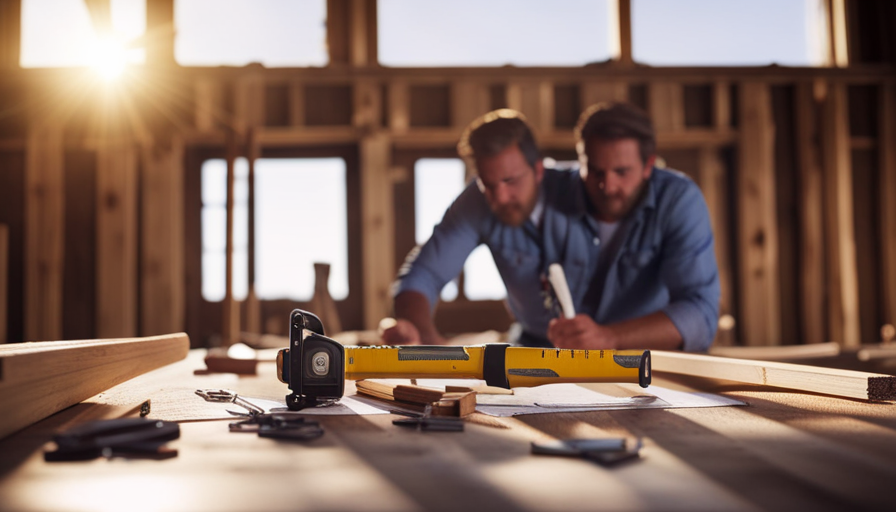When embarking on the exciting journey of building a small home, it is crucial to consider the height of the trailer above the ground.
Imagine this: you’re driving down the road, towing your tiny house, and suddenly you encounter an unexpected bump. Without the proper clearance, your dream home could suffer some serious damage. That’s why it’s essential to understand the basics of trailer height for tiny houses.
In this article, I will delve into the precise measurements and factors that influence the trailer height for your tiny house. We’ll explore the benefits of having a higher trailer, as well as potential challenges that may arise. Additionally, I’ll provide you with tips on how to safely and securely elevate your tiny house, ensuring its longevity and stability.
So, whether you’re a DIY enthusiast or planning to hire a professional builder, join me as we dive into the technical intricacies of trailer height for tiny houses. Let’s make sure your dream home stays safe and secure on the road.
Key Takeaways
- Trailer height is crucial for the safety and stability of a tiny house.
- Factors such as weight, towing vehicle, size, and weight considerations influence trailer height.
- Higher trailers offer benefits such as increased weight capacity, improved towing dynamics, and enhanced ground clearance.
- However, height restrictions, clearance issues, and potential structural implications can be challenges when customizing the trailer height.
Understanding the Basics of Tiny House Trailers
Do you ever wonder how high your trailer needs to be off the ground when building your tiny house? It’s an important question to consider as you want to ensure that your tiny house is safe and secure while being towed.
Determining the ideal trailer height for your tiny house depends on a few factors, including the weight of your trailer and choosing the right towing vehicle. First, let’s talk about determining the weight of your trailer. It’s crucial to know the weight of your tiny house trailer as it will help you determine the appropriate trailer height. To determine the weight, you can use a trailer scale or consult the manufacturer’s specifications. Once you have the weight, you can move on to choosing the right towing vehicle.
Choosing the right towing vehicle is essential for maintaining stability and safety while towing your tiny house. The towing vehicle should have the appropriate towing capacity to handle the weight of your tiny house trailer. It’s recommended to consult your vehicle’s manual or speak with a professional to ensure you have the right towing vehicle for your tiny house.
Now that you understand the basics of tiny house trailers, let’s move on to determining the ideal trailer height for your tiny house.
Determining the Ideal Trailer Height for Your Tiny House
Determining the optimal height for the foundation of your compact dwelling requires careful consideration. When determining the ideal trailer height for your tiny house, two key factors come into play: determining trailer size and trailer weight considerations.
When it comes to determining the size of the trailer, you need to consider the dimensions of your tiny house. Measure the height of your tiny house, including any rooftop additions such as solar panels or air conditioning units. This measurement will give you a starting point for the trailer height.
Next, you need to take into account the weight considerations of your tiny house. The weight of your tiny house will determine the type of trailer you need, as well as the height required to ensure proper weight distribution and towing stability. It’s essential to consult with a professional to determine the appropriate trailer weight capacity and height for your specific tiny house.
These two factors, determining trailer size and trailer weight considerations, are crucial in determining the height of your tiny house trailer. By carefully considering these factors, you can ensure that your tiny house is securely and properly elevated.
The next section will explore the various factors that influence trailer height, providing further insight into this important decision.
Factors That Influence Trailer Height
One key aspect to consider when determining the ideal height for your compact dwelling is understanding the factors that influence the elevation of your trailer. The height of a trailer for a tiny house is influenced by several factors, including the type of foundation, the desired ground clearance, and the overall design and dimensions of the house.
To help you better understand these factors, let’s take a closer look at a table that outlines the main factors that influence trailer height:
| Factors | Description |
|---|---|
| Type of Foundation | The choice between a traditional trailer frame or a custom chassis |
| Desired Ground Clearance | The amount of space between the bottom of the trailer and the ground |
| Overall Design | The dimensions and layout of the tiny house, including any loft |
By considering these factors, you can determine the ideal height for your trailer, ensuring that your tiny house is not only functional but also meets your specific needs.
Understanding the factors that influence trailer height is crucial as it directly impacts the overall functionality and usability of your tiny house. Having a higher trailer can provide several benefits, which we will explore in the subsequent section.
Benefits of Having a Higher Trailer
Having a higher trailer for a tiny house has numerous benefits. Firstly, it enhances durability and stability. A higher trailer provides a stronger foundation for the structure, allowing it to withstand various weather conditions and potential shifting of the ground.
Secondly, it offers increased storage options. With more vertical space available, there’s room for additional storage compartments or even a loft area, maximizing the usable space within the tiny house.
Lastly, a higher trailer allows for better insulation and ventilation, as it creates more room for insulation materials and air circulation under the house.
Enhanced Durability and Stability
To ensure your tiny house remains steadfast and resilient, imagine the robustness of a towering mountain peak as your trailer sits high off the ground. This elevated position provides enhanced durability and stability, ensuring that your tiny house can withstand the challenges of the road. Here are three key benefits of having a higher trailer:
-
Increased weight capacity: A higher trailer allows for a greater weight capacity, enabling you to add more features and amenities to your tiny house without compromising structural integrity.
-
Impact on towing dynamics: With the trailer positioned higher, the towing dynamics are improved. The higher center of gravity reduces swaying and improves overall towing stability, making your journey safer and more comfortable.
-
Enhanced ground clearance: A higher trailer provides increased ground clearance, allowing you to navigate rough terrains and uneven surfaces with ease.
With these advantages in mind, let’s explore the next section about the increased storage options available for your tiny house.
Increased Storage Options
Imagine how much more storage space you’ll have in your compact living space with the increased storage options available in your tiny abode. Creative space utilization is key when it comes to maximizing storage capacity in a tiny house. One effective way to achieve this is by incorporating multi-functional furniture pieces that serve multiple purposes. For example, a sofa that can also be converted into a bed or a coffee table with hidden storage compartments. Additionally, utilizing vertical space is crucial in a tiny house. Installing shelves or cabinets on the walls can provide ample storage for books, kitchen items, or decorative pieces. Furthermore, consider using under-the-bed storage or utilizing the space under the stairs for additional storage options. These techniques will help you make the most of your limited space. Transitioning to the subsequent section about the potential challenges of a higher trailer, it is important to address the structural implications that come with an elevated height.
Potential Challenges of a Higher Trailer
When considering the potential challenges of a higher trailer for a tiny house, two key points come to mind:
-
Height restrictions and clearance issues can be a major concern when opting for a higher trailer. Municipal regulations and transportation limitations may restrict the maximum height allowed, and clearance issues can arise when navigating under bridges or through low-hanging branches.
-
The decision to have a higher trailer may result in additional costs for customization and modifications. This could include reinforcing the structure to handle the increased height, modifying the design to accommodate for the higher trailer, and potentially needing specialized equipment for transportation and installation.
Height Restrictions and Clearance Issues
Watch out for low-hanging branches and narrow bridges – you’ll need to keep in mind the height restrictions and clearance issues when towing your tiny house trailer.
It’s important to understand the height restrictions imposed by local authorities and construction regulations. Most jurisdictions have specific limitations on the maximum height of trailers on public roads, typically ranging from 13 to 14 feet. Exceeding these restrictions can result in fines or even denial of permits for transportation.
Additionally, clearance issues can arise when passing under bridges, overpasses, or tunnels. It’s crucial to measure the height of your tiny house, including any rooftop features, to ensure it complies with these regulations and can safely navigate through clearances. Failure to account for height restrictions and clearance issues can lead to significant delays and potential damage to your tiny house.
Make sure to plan accordingly and consider these factors when designing and building your tiny house trailer. Keep in mind that these restrictions may require additional costs for customization and modifications to meet the height limitations and clearance requirements.
Additional Costs for Customization and Modifications
Don’t overlook the potential financial burden of customization and modifications when it comes to your tiny house trailer – these additional costs can quickly add up and leave you feeling overwhelmed. It’s important to carefully consider the customization costs and modifications expenses before embarking on your tiny house journey. Here are four crucial factors to keep in mind:
-
Design alterations: Customizing your tiny house trailer to fit your unique vision may require structural changes, such as adding extra windows or extending the roofline. These alterations can significantly increase the overall cost.
-
Interior modifications: From installing custom cabinetry to upgrading appliances, the expenses for modifying the interior can quickly escalate. Consider the desired level of luxury and functionality when budgeting for these modifications.
-
Energy-efficient upgrades: Incorporating sustainable features like solar panels or energy-efficient insulation may require additional upfront investment but can save money in the long run.
-
Safety and code compliance: Ensuring your tiny house meets safety standards and local building codes may involve additional expenses for inspections and necessary adjustments.
Considering these customization and modification costs is crucial when finding the right trailer height for your tiny house design.
Finding the Right Trailer Height for Your Tiny House Design
Choosing the right trailer height for your tiny house design is like finding the perfect puzzle piece to create a harmonious and elevated living space. It requires careful consideration of both the trailer weight and towing capacity to ensure a safe and secure foundation for your tiny house. To help you make an informed decision, I have prepared a table comparing different trailer heights and their corresponding benefits:
| Trailer Height (inches) | Benefits |
|---|---|
| 12 | Low center of gravity for better stability during towing |
| 18 | Allows for additional storage space underneath the tiny house |
| 24 | Provides ample headroom inside the tiny house for taller individuals |
| 30 | Offers the option to install a loft area for additional living or sleeping space |
By understanding the advantages of different trailer heights, you can tailor your tiny house design to meet your specific needs and preferences. Once you have chosen the right trailer height, you can move on to the next step of safely and securely elevating your tiny house. This includes implementing proper anchoring techniques and utilizing sturdy materials to ensure your tiny house remains stable and secure, even in adverse weather conditions.
Tips for Safely and Securely Elevating Your Tiny House
When it comes to elevating your tiny house, it’s crucial to ensure safety and security. There are various techniques you can use to raise your tiny house off the ground, and it’s essential to choose the right method for your specific needs.
One common technique is using jacks to lift the trailer. This method allows for precise adjustments to be made, ensuring a level foundation for your tiny house.
Another option is using blocks or piers to elevate the trailer. This method provides stability and allows for easy leveling.
Additionally, you can consider using a combination of jacks and blocks for added support and security.
Once your tiny house is elevated, it’s crucial to secure it properly. This can be achieved by using anchor systems, such as ground screws or concrete footings, to prevent any movement or shifting.
Additionally, using straps or chains to secure the tiny house to the trailer can provide extra stability.
By employing these elevating techniques and securing methods, you can ensure the safety and stability of your tiny house.
Now, let’s move on to discussing the maintenance and upkeep of the trailer.
Maintenance and Upkeep of the Trailer
Keep your home on wheels in tip-top shape by regularly maintaining and caring for the trailer. Proper maintenance is crucial to ensure the longevity and safety of your tiny house. To help you with this, here are some maintenance tips and a trailer inspection checklist.
Firstly, make sure to inspect the trailer regularly for any signs of wear and tear. Check the tires for proper inflation, tread wear, and any signs of damage. Look for any loose or missing bolts and tighten or replace them as necessary.
Inspect the hitch and coupler for any signs of rust or damage and lubricate them regularly to ensure smooth operation.
Next, inspect the trailer frame for any signs of corrosion or rust. If you find any, treat it immediately to prevent further damage. Check the wheel bearings and axles for proper lubrication and replace them if needed.
Inspect the electrical system, including the lights and wiring, and repair or replace any faulty components.
Lastly, check the trailer’s brakes and suspension system. Make sure they are in good working condition and adjust or replace them if necessary. Clean and lubricate the jacks and stabilizers to ensure smooth operation.
By following this trailer inspection checklist and performing regular maintenance, you can keep your tiny house trailer in excellent condition. Now, let’s explore additional features and accessories for your tiny house trailer.
Additional Features and Accessories for Your Tiny House Trailer
One interesting fact about adding additional features and accessories to your tiny house trailer is that they can greatly enhance the functionality and comfort of your mobile home. Here are four customization options to consider for your tiny house trailer:
-
Solar panels: By installing solar panels on the roof of your trailer, you can harness the power of the sun to generate electricity for your tiny home. This eco-friendly option allows you to live off the grid and reduce your carbon footprint.
-
Exterior storage compartments: Adding storage compartments to the exterior of your trailer provides extra space for tools, equipment, and outdoor gear. These compartments can be customized to fit your specific needs and can help keep your tiny home organized and clutter-free.
-
Awning or porch: A retractable awning or porch can create additional outdoor living space, allowing you to enjoy the fresh air and scenery. It provides a shaded area to relax or entertain guests, and can be easily folded away when not in use.
-
Safety features: When customizing your tiny house trailer, it’s important to consider safety considerations. This can include adding smoke detectors, carbon monoxide detectors, fire extinguishers, and security systems to ensure the well-being of you and your home.
Adding these additional features and accessories to your tiny house trailer can greatly enhance your mobile living experience. In the next section, we will discuss final thoughts on trailer height for tiny houses.
Final Thoughts on Trailer Height for Tiny Houses
The height of your mobile dwelling is a crucial factor to consider when designing your compact living space. When it comes to tiny house trailers, customization is key. You have the ability to choose the height that suits your needs and preferences. However, it is important to take safety considerations into account.
One of the main aspects to think about when determining the height of your trailer is the overall clearance. This refers to the distance between the ground and the bottom of your tiny house. It is crucial to ensure that there is enough clearance to avoid any damage to the structure while on the road. Additionally, you need to consider any potential obstacles such as low bridges or tree branches that may come in contact with your tiny house.
To help you visualize the importance of trailer height customization and safety considerations, let’s take a look at the following table:
| Height (inches) | Clearance (inches) | Safety Rating |
|---|---|---|
| 60 | 18 | Good |
| 64 | 22 | Excellent |
| 68 | 26 | Outstanding |
As you can see, increasing the height of your trailer can provide better clearance and improve the safety rating. However, it is important to find the right balance between height and stability. A higher trailer may increase the risk of tipping over, especially during strong winds or on uneven terrains.
Trailer height customization is an important aspect of designing your tiny house. By considering safety considerations and finding the right balance, you can ensure a comfortable and secure living space on the road.
Frequently Asked Questions
How much weight can a tiny house trailer support?
A tiny house trailer can support a maximum weight capacity determined by several factors. When considering the weight capacity, it’s crucial to take into account the trailer’s structural integrity, axle rating, tire load rating, and hitch capacity. These factors ensure the safe towing and stability of the tiny house. Therefore, the weight capacity of a tiny house trailer can vary, ranging from 7,000 pounds to 18,000 pounds, depending on these considerations.
What are the different types of trailers available for tiny houses?
There are several different types of trailers available for tiny houses, each with their own advantages and disadvantages.
One type is the flatbed trailer, which provides a solid foundation for the tiny house and allows for easy customization. However, it may require additional steps for insulation and plumbing.
Another type is the drop axle trailer, which offers a lower height and easier access but may have limitations on weight capacity.
It’s important to carefully consider the specific needs and requirements of your tiny house when choosing a trailer.
Can I build a tiny house on a trailer without any experience?
Building a tiny house on a trailer is a feasible option for beginners, but it’s not recommended. It requires a thorough understanding of structural integrity, electrical and plumbing systems, and building codes. Without proper knowledge and skills, there is a higher risk of mistakes and safety hazards. It’s advisable to seek guidance from experts or gain experience before attempting such a project.
Are there any regulations or building codes specific to tiny house trailers?
When it comes to building a tiny house on a trailer, it’s crucial to be aware of the regulations and building codes specific to these structures. These guidelines ensure safety and compliance with local laws.
One interesting statistic is that as of 2021, there are over 200 cities in the United States that have specific zoning regulations for tiny houses. These regulations often include requirements for trailer size, weight limits, and structural standards to ensure a secure and well-built tiny house.
How does the height of the trailer affect the overall stability of the tiny house?
The height of the trailer plays a crucial role in determining the overall stability of the tiny house. A lower trailer height provides a lower center of gravity, which enhances stability during transportation and when parked.
It also impacts the design and layout of the tiny house by limiting the vertical space available. Designers must carefully consider the height to ensure the house remains structurally sound while providing adequate headroom and functional living space.
Conclusion
After carefully considering all the factors and benefits, it’s clear that the ideal height for a trailer in a tiny house is crucial.
With a higher trailer, you can enjoy better insulation, improved stability, and increased storage space. However, it’s important to note that challenges may arise, such as increased wind resistance and the need for additional safety measures.
By following proper maintenance and utilizing additional features, you can safely elevate your tiny house and create a secure and comfortable living space. So, make sure to choose the perfect trailer height for your tiny house and embark on your unique adventure.
Hi, I’m Emma. I’m the Editor in Chief of Tiny House 43, a blog all about tiny houses. While tree houses are often associated with childhood, they can be the perfect adult retreat. They offer a cozy space to relax and unwind, surrounded by nature. And since they’re typically built on stilts or raised platforms, they offer stunning views that traditional homes simply can’t match. If you’re looking for a unique and romantic getaway, a tree house tiny house might just be the perfect option.
















